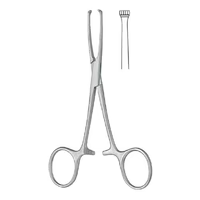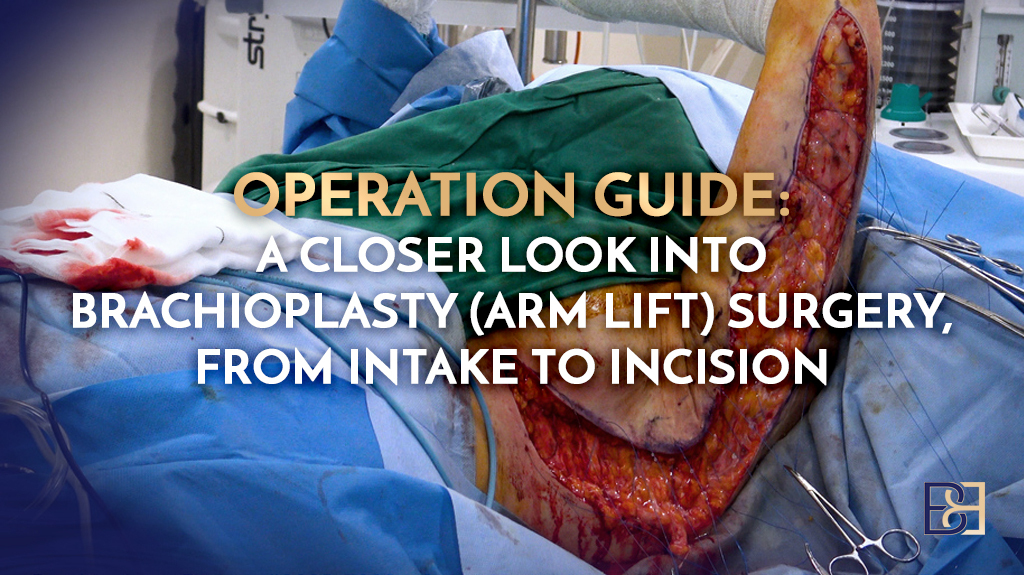Loose skin on the arms is quite common after massive weight loss due to bariatric surgery, post-pregnancy, or diet and exercise. And in a hot climate like Australia, it is difficult to hide that loose skin under baggy clothing. Brachioplasty, commonly known as an arm lift, is a surgical procedure designed to tighten and remove excess skin, while also helping with functionality.

Tattoo (upper back) and face blurred for privacy
Disclaimer: Operation performed by Dr Bernard Beldholm. Adult content, surgery has risks; individual results vary, seek 2nd opinion. Please see the full disclaimer.
This article is intended to provide an up-close view into what happens inside the operating room during brachioplasty surgery so you are fully armed with all of the information you need.

Book your appointment online now
Arm Lift Surgery (Brachioplasty) Operation Guide
Below, I have provided a deep look into the actual brachioplasty procedure, from intake to incisions and beyond. More in-depth articles regarding brachioplasty and other body contouring surgeries can be seen in the blog as well.

Consultation Phase
Before your arm lift (brachioplasty) you will come into my office for a consultation. On the first visit, I’ll ask you to point to which body parts you want to focus on, review your medical history, discuss your cosmetic goals, ask about any problems you experience related to lax skin after massive weight loss, and conduct a thorough physical exam to determine the extent of extra skin and fat in the areas you want to refine. I will also review the possible risks involved, downtime, recovery, etc.
Intake Phase
On the day of surgery, you’ll arrive at the hospital and check in. A nurse will greet you, take your vitals, and ask you to change into a surgical gown.
I will meet you to discuss any of your last-minute concerns.

Surgery Preparation Phase in Anaesthesia Bay
Preoperative Markings
While you are awake and standing upright in the anaesthetic bay, I will draw markings on your arms. These markings will serve as a guideline during the operation.
Anaesthesia Administered

While laying on the operating table, an anaesthetist will administer a sedation drug injected directly through an IV. You will begin to feel drowsy as the anaesthesia takes effect. Your eyes will feel heavy; your body relaxes, and, finally, you’ll drift off to sleep.
After intake, the procedure begins. While there are many types and levels of anaesthesia (medication to keep you from feeling pain during surgery), general anaesthesia is most commonly used for major operations like abdominoplasty, breast augmentation, and brachioplasty.
The anaesthetist will continue to monitor your vitals during surgery to make sure they are normal and steady and that you are unaware and pain-free from the moment you fall asleep to the moment you wake.
Surgical Phase
Body Positioning
Once you’re sedated, the surgery begins. The first step to a successful arm lift (brachioplasty) is making sure you’re properly positioned on the operating table.
You will be on your back, fully sedated with your arms placed into arm bars. The arm bars hold your arms upright during surgery. Your hands are secured to the arm bars to make sure your arms are firmly in place.

VASER Liposuction (suction-assisted lipectomy)
The next step is Vibration Amplification of Sound Energy at Resonance, (VASER) liposuction (suction-assisted lipectomy). VASER is considered a more controlled procedure, and it requires a skilled and experienced provider. Liposuction (suction-assisted lipectomy) also dissects the tissue so less cutting is needed in the next step. The benefit of liposuction (suction-assisted lipectomy) is not just arm fat removal. It also frees the tissue so I can avoid cutting down to the muscle, resulting in less tissue trauma and decreased pain in recovery.
VASER suction-assisted lipectomy (liposuction) is done in 3 steps
A wetting solution made of adrenaline and local anaesthetic is applied to the tissues, helping to stiffen and isolate the fat cells, and reduce bleeding and bruising.

NOTE: VASER Suction-Assisted Lipectomy (Liposuction), is not a weight loss tool. People who have the best results with VASER liposuction are already within 7 kilograms (15 pounds) of their ideal weight. This procedure is for people who are trying to spot-treat fat deposits and reveal muscle tone underneath.
For more information about VASER Suction-Assisted Lipectomy (Liposuction), refer to my related articles.
Marking Loose Skin

After the arm fat is gone, I will adjust the surgical markings. These markings help me plan the incision and ensure that the arm lift (brachioplasty) scar is a neat, straight line. This step is very important. Since all surgery leaves a scar, it is essential to make the scar as attractive-looking as possible.
Identify the Extent of Skin to Be Removed

Using Alice Forceps, the extent of skin to be removed is identified using surgical clamps that hold your skin in place.

This allows me to get a picture of what your arms will look like once the loose skin is removed. While the clamps are in place, I am able to feel where the muscles and underlying tissues lie. The goal is to remove the exact amount of skin that can be removed— not too much and not too little.
Excising the Loose Skin on the Right Arm

The next step is excising the excess skin. Using the markings as a guide, I will make two long incisions from your elbow to your underarm. Thanks to VASER liposuction (suction-assisted lipectomy), the underlying tissue will be pre-loosened.
The incision must not go too deep; just enough to get under the skin. There is a fine line between removing too much skin and not removing enough. Upper arm skin tends to loosen a bit within the first six months of recovery once the swelling comes down so I make it as tight as possible while still being able to close the incision.
Closing the Incision

Immediately after the surgery is complete, I begin to apply sutures. I use dissolving sutures for all my surgeries.
Dissolving Sutures: Placed in the upper layers, these sutures will take between 90 and 180 days to dissolve naturally.
Permanent Sutures: These are only use to initially bring the tissues together. They are removed before the end of the surgery.
Your arms will be swollen at first. However, once the fluid dissipates in a day or two, the tissues will relax and the swelling will go down. Swelling will continue to subside over the next few months.

Repeat Steps on the Left Arm
Once the right arm is complete, I will repeat the steps on the left arm. The arm lift (brachioplasty) surgery time is one to three hours, though some procedures are longer than others.
Postoperative Phase

Compression Garment
Once the surgery is complete, you will be brought to the recovery room while the effects of the general anaesthetic wear off. You will wear compression garments on your arms for several weeks after surgery to minimise swelling and aid healing.
Arm Lift (brachioplasty) Recovery
Typically performed as an overnight or day-stay procedure, I prefer to keep an eye on my patients for the first 24 hours after Brachioplasty in case of complications. Though arm lift (brachioplasty) recovery times vary from patient to patient, most patients experience pain, swelling, and some fluid build-up after the procedure.
Postoperative Pain
Post-op pain will occur in varying degrees, from severe to moderate on the first day, gradually decreasing over the next few days. While in the hospital, pain will be managed with IV medications. At the time of discharge, patients receive a prescription for meds to continue with pain management at home.
Worsening pain that is unresponsive to meds should be brought to my attention as this may be a sign that complications are developing. Though chronic pain, from mild aches to sharp nerve pain can persist for more than one year however this it is very rare.
Swelling
Swelling can be managed with the use of compression garments, which are to be worn for approximately 4-6 weeks.
Seroma
A condition involving excess fluid building up under the skin’s surface, seroma is excessive fluid build-up between the skin and underlying supportive tissue.
Potential Arm Lift (brachioplasty) Risks and Medical Complications
As with any surgery, there is always the potential for complications with an arm lift (brachioplasty) surgery.
For more information on the risks and potential complications see our comprehensive blog article on this topic: Arm Lift (Brachioplasty) Risks
Returning to Work and Exercise
Patients with office/desk or other sedentary jobs that do not involve strenuous physical demands can generally return to work after two weeks. Patients with jobs requiring rigorous upper body movements and heavy lifting such as painters, construction workers, or factory labourers should take off from work for at least 4-6 weeks. Less physically demanding, non-sedentary occupations such as nursing, teaching, and food service jobs may also require additional time off to recover before returning to work.
It is also advised to delay returning to strenuous exercise, particularly that involving the arms for 6 to 8 weeks.
To minimise swelling, avoid excessive bleeding, prevent wound infection, and impair healing, I encourage patients to maintain a healthy lifestyle, get plenty of rest, maintain a healthy weight, take it slow, eat a healthy diet, refrain from smoking, and follow post-operative instructions.
For more information on Arm Lift (Brachioplasty) recovery see our dedicated blog article on this topic.
Final Thoughts

Disclaimer: Operation performed by Dr Bernard Beldholm. Adult content, surgery has risks; individual results vary, seek 2nd opinion. Please see the full disclaimer.


